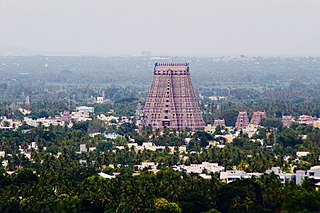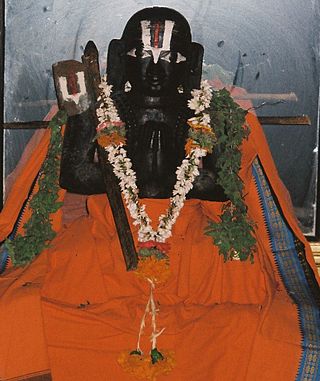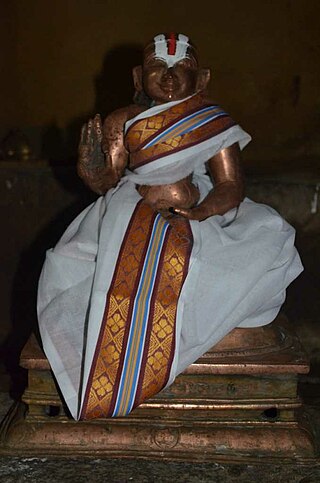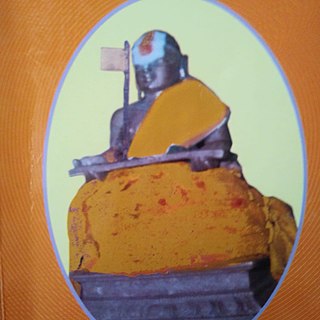Related Research Articles

Srirangam is a neighbourhood in the city of Tiruchirappalli in the Indian state of Tamil Nadu. A river island, Srirangam is bounded by the Kaveri River on one side and its distributary Kollidam on the other side. Considered as the first among the 108 Divya Desams, a group of Vishnu temples, it is famous for the Ranganathaswamy Temple, the largest temple complex in India and the biggest functioning Hindu temple in the world. Srirangam is also home to a significant population of Sri Vaishnavas.

Ramanuja, also known as Ramanujacharya, was an Indian Hindu philosopher, guru and a social reformer. He is noted to be one of the most important exponents of the Sri Vaishnavism tradition within Hinduism. His philosophical foundations for devotionalism were influential to the Bhakti movement.

Mundkur is a village in Karkala Taluk, Udupi district, Karnataka, India. The Durga Parameshwari temple located here was built circa 9th century AD.

Bramhatantra Swatantra Parakala Matha, commonly known as Parakala Matha, is a Hindu Sri Vaishnava monastery founded during the Hoysala Empire in 1268 at Mysore, Karnataka, primarily worshipping Vishnu and Lakshmi as Hayagriva and Vargeshi. It is the first mediaeval era monastery of the Vadakalai denomination within Vaishnavism in the Hindu society and is the gurupeeta, the seat of the royal guru, of the maharajas of Mysore.

Dakṣiṇāmnāya Śrī Śāradā Pīṭham or Śri Śṛṅgagiri Maṭha ; Sanskrit: मठ, maṭha) is one amongst the four cardinal pīthams following the Daśanāmi Sampradaya - the peetham or matha is said to have been established by acharya Śrī Ādi Śaṅkara to preserve and propagate Sanātana Dharma and Advaita Vedānta, the doctrine of non-dualism. Located in Śringerī in Chikmagalur district in Karnataka, India, it is the Southern Āmnāya Pītham amongst the four Chaturāmnāya Pīthams, with the others being the Dvārakā Śāradā Pītham (Gujarat) in the West, Purī Govardhana Pīṭhaṃ (Odisha) in the East, Badri Jyotishpīṭhaṃ (Uttarakhand) in the North. The head of the matha is called Shankarayacharya, the title derives from Adi Shankara.

Vedanta Desika (1268–1369), also rendered Vedanta Desikan, Swami Vedanta Desika, and Thoopul Nigamantha Desikan, was an Indian polymath who wrote philosophical as well as religious and poetical works in several languages, including Sanskrit, Manipravaḷam, Tamil and Prakrit. He was an Indian philosopher, Sri Vaishnava guru, and one of the most brilliant stalwarts of Sri Vaishnavism in the post-Ramanuja period. He was a Hindu devotee, poet, Master of Acharyas (desikan) and a logician and mathematician. He was the disciple of Kidambi Appullar, also known as Athreya Ramanujachariar, who himself was of a master-disciple lineage that began with Ramanuja. Vedanta Desika is considered to be avatar (incarnation) of the divine bell of Venkateshvara of Tirumala by the Vadakalai sect of Sri Vaishnavism. Vedanta Desika belongs to Vishvamitra/Kaushika gotra.
Jagadguru, literally meaning "guru of the universe", is a title used in Sanātana Dharma. Traditionally, it has been bestowed upon or used for ācāryas belonging to the Vedānta school who have written Sanskrit commentaries on the Prasthānatrayī – the Brahma sūtras, the Bhagavad-gītā and the principal Upaniṣads. Historically, jagadgurus have established a lineage and an institution to spread dharma which has been based in Varanasi, the centre of Sanskrit study.

Vāraṇādrīśa, more commonly referred to as Pillai Lokacharya, was a prominent Sri Vaishnava leader and philosopher who authored several works important to Vishishtadvaita philosophy.

Jagadguru Shri Chandrasekharendra Saraswati Shankaracharya Mahaswamigal also known as the Sage of Kanchi or Mahaperiyavar was the 68th Jagadguru Shankaracharya of the Moolamnaya Saravjna Kanchi Kamakoti Peetham. Mahaperiyavar's discourses have been recorded in a Tamil book titled "Deivathin Kural".

Alagiya Manavalan, best known by his epithet Manavala Mamunigallit. 'The great saint, Manavalan' (1370–1450), was a Hindu theologian. He was a major proponent of the Sri Vaishnavism tradition in the 15th century in Tamilakam, disseminating it with the help of his eight disciples. The disciples of Manavalan established places of learning to teach the Vishishtadvaita philosophy in Tamilakam.

Ramtek is a city and municipal council in Nagpur district of Maharashtra, India.

Shilpa Shastras literally means the Science of Shilpa. It is an ancient umbrella term for numerous Hindu texts that describe arts, crafts, and their design rules, principles and standards. In the context of Hindu temple architecture and sculpture, Shilpa Shastras were manuals for sculpture and Hindu iconography, prescribing among other things, the proportions of a sculptured figure, composition, principles, meaning, as well as rules of architecture.

Sri Vaishnavism is a denomination within the Vaishnavism tradition of Hinduism, predominantly practiced in South India. The name refers to goddess Lakshmi, as well as a prefix that means "sacred, revered", and the god Vishnu, who are together revered in this tradition.

The Bhaktāmara Stotra is a Jain religious hymn (stotra) written in Sanskrit. It was authored by Manatunga. The Digambaras believe it has 48 verses while Śvetāmbaras believe it consists of 44 verses.

Jain literature refers to the literature of the Jain religion. It is a vast and ancient literary tradition, which was initially transmitted orally. The oldest surviving material is contained in the canonical Jain Agamas, which are written in Ardhamagadhi, a Prakrit language. Various commentaries were written on these canonical texts by later Jain monks. Later works were also written in other languages, like Sanskrit and Maharashtri Prakrit.
Lathanga is a village in the state of Odisha, India with its postal Zip code 754140. Lathanga is the corrupt form of the Sanskrit word 'Rathaanga' which means 'like the body of a chariot'. This village has become very much known among the people due to its contribution to the triple Ss i.e. Sekhareswar, [Sanskrit

Madhava Temple,, is the temple dedicated to Lord Vishnu. It is located at the Madhab village of Niali block in Cuttack district, Odisha.
Prathivadhi Bhayankaram Aṇṇan was a Sri Vaishnava acharya, Tamil and Sanskrit scholar, and the composer of the popular Venkateswara Suprabhatam.

Bero railway station serves Bero and surrounding villages in Purulia district in the Indian state of West Bengal.

Ayee Jananyacharya or Devaraja Perumal was a Hindu Sri Vaishnava religious leader, great saint, and one of the important propagator of the Sri Vaishnavism tradition. Sri Jananyacharya Swami was Seventh in the lineage of Sri Ramanujacharya. He was a scholar in ubhaya vedanta who took Vishishtadvaita school of vedanta to the next level and widely popularized and propagated the Sri Vaishnava tradition.
References
- ↑ "Sukreswar Temple".
- ↑ "Sukreswar Mandir, Guwahati - Timings, History, Darshan, Pooja Timings". Trawell.in. Retrieved 1 September 2024.
20°16′17″N86°26′09″E / 20.271430°N 86.435778°E